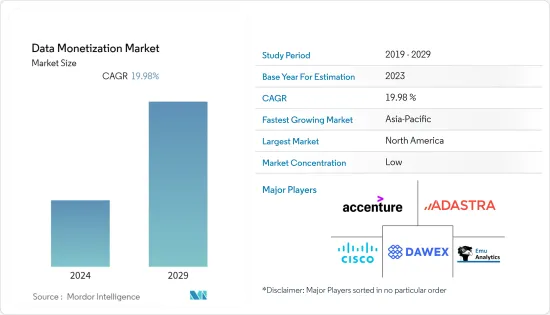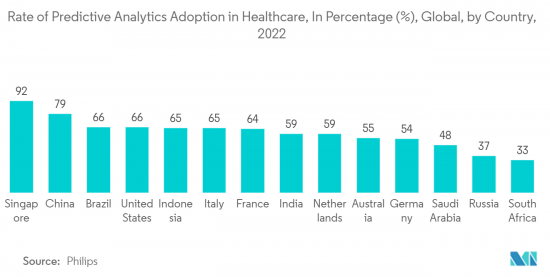 |
市场调查报告书
商品编码
1406274
资料货币化:市场占有率分析、产业趋势/统计、成长预测,2024-2029Data Monetization - Market Share Analysis, Industry Trends & Statistics, Growth Forecasts 2024 - 2029 |
||||||
※ 本网页内容可能与最新版本有所差异。详细情况请与我们联繫。
预计2024年资料货币化市场规模为48.7亿美元,预计2029年将达到149.9亿美元,复合年增长率为19.98%。
随着公司对发现资料越来越感兴趣,资料货币化正在获得越来越多的关注。而且,资料变现不仅需要业务和技术专家的结合,还需要时间、精力和投资,技能互补。

主要亮点
- 在当前的市场情况下,独立软体供应商正在转向自助式商业智慧来增加应用程式收益并使其产品脱颖而出。同样,自助服务 BI 可以透过提高采用率和提高营运效率来为开发应用程式的公司提高应用程式投资回报率。
- 新技术推动了资料成长,使资料呈指数级增长。这些技术包括边缘运算、5G网路、物联网(IoT)、人工智慧(AI)和机器学习(ML)、增强智慧和虚拟实境(AR/VR)以及区块链。资料量、种类和速度的空前成长正在增加资料货币化的潜力。
- 例如,电子商务等新经营模式的出现正在极大地推动资料货币化行业的成长。这是因为电子商务网站有能力根据使用者的搜寻行为和购买模式收集大量资料。因此,电商玩家可以采用资料货币化解决方案来出售资料,或与品牌合作分析资料并利用它来实现各种业务目标,从而赚取额外收入。
- 与其他产业相比,医疗保健产业面临着碎片化的资料格局,并继续面临监管限制、互通性挑战和参与者之间不信任的挑战。医疗保健业务各个方面的标准化和正规化都是一个挑战,因为没有全国通用的患者标识符,资料规范化和互通性问题给构建功能强大的资料存储库带来了挑战,数位化资料的利用变得困难。
- 此外,随着消费者对个人资料使用意识的不断增强,世界各地正在製定多项资料安全法规,例如GDPA、CCPA等。这些法律提供了严格的框架,以避免滥用消费者的个人资料,这可能会对所研究市场的成长产生负面影响。
- 由于 COVID-19 大流行,几乎每个行业都在经历客户购买行为的波动、风险和变化。世界各地的公司被迫对其营运进行重大改变,包括缩小规模并使其产品和服务多样化。为了快速应对这些变化,企业正在透过人工智慧系统、敏捷风险管理和资料分析来采用或利用商业智慧策略,以确保他们在疫情期间充分了解情况以继续业务运营,这有助于我们据此做出决策资讯。预计这将在预测期内为所研究的市场创造新的商机。
资料货币化市场趋势
医疗保健产业占主要市场份额
- 在医疗保健行业,由于过去几年医疗数位化的进步,资料正在迅速增加。健康记录和电子健康记录(EHR) 正在迁移到云端,穿戴式装置和智慧型装置也变得极为普遍。数位化趋势正在为该领域的资料货币化铺平道路,有助于增强临床服务并实现财务回报。
- 资料分析和物联网设备的日益普及将在该领域产生更多资料。根据飞利浦进行的一项调查,截至 2022 年 2 月,新加坡接受调查的医疗保健领导者中有 92% 表示他们已经或正在其医疗保健组织中实施预测分析。因此,资料货币化服务的范围将会扩大。此外,世界各地的医疗保健组织已经认识到资料是真正的企业资产,并透过分析从该资产中获益。有竞争力的医疗保健组织正在将这些分析收益,以创造新的收益来源并提升其在价值链中的地位。
- 行业专家认为,去识别化患者资料的商业用途只会促进和加速医疗服务模式的创新,并透过以更低的成本改善结果来使医疗保健消费者受益。透过与数位健康企业家和研究人员共用资料存取权限,他们可以使用先进的分析技术获得有用见解的工具,不仅可以创新护理服务,还可以创新许多其他事物。我们相信,这也可以改变游戏规则。
- 考虑到成长潜力,医疗保健产业的市场供应商正在提供符合资料隐私法的创新资料货币化解决方案。例如,2022 年 10 月,医疗保健 AI 和 NLP 公司、Spark NLP 库的开发商 John Snow Labs 宣布对其自动去识别解决方案进行改进。 John Snow Labs 透过实现大型资料集的自动去识别化,帮助世界各地的医疗保健组织创新产品并降低成本。该公司的自动化去识别识别解决方案提供资料货币化所需的自订。
- 此外,在美国,14 个最大的卫生系统正在与一家新新兴企业Truveta Inc. 合作,以汇集其庞大且多样化的资料,并控制去识别化患者资料的共用和使用方式。该新兴企业旨在利用患者资料来加强患者护理、加速治疗方法的开发、解决健康差异并缩短诊断时间。因此,这种趋势的扩大预计将在预测期内推动所研究市场的成长。

亚太地区可望成为快速成长的市场
- 亚太地区新技术的采用正在蓬勃发展。此外,人工智慧、物联网和巨量资料技术的商业化以及对进一步技术进步以创造性利用这些技术的需求预计将推动该地区资料货币化工具和服务的采用。网路技术的不断进步、电子商务的快速繁荣、製造业和汽车行业的成长以及强制收紧的法规也对该地区的成长产生了积极影响。
- 该地区的各种金融服务机构 (FSI)持有大量有价值的资料,可以将这些数据货币化以获得可观的收益。例如,从数据到数位化使 FSI 能够进行数位竞争并利用数位转型的优势。此外,这些资产透过数据到数位转型后可以产生大量新的收益来源。 FSI 还可以透过更好地利用资料资料分析、创建数据主导的解决方案以及建立洞察和服务平台来实现资料收益。
- 鑑于庞大的消费群以及智慧型手机和其他手持设备的不断普及,能够获得有洞察力的资料的公司有可能从最近变得非常流行的行动装置上的广告商那里获得可观的收益。资料货币化预计将在亚太地区由于
- 因此,资料货币化的潜力正在鼓励供应商采用创新的商务策略,从资料中产生最大的价值。例如,通讯服务供应商中国联通已使用区块链创建新的资料货币化流。该公司的目标是与企业客户共用资料,同时遵守安全和隐私法规,并专注于管理费用和资料储存。
资料货币化产业概述
由于全球参与者和中小企业的存在,资料货币化市场竞争非常激烈。资料货币化应用于各个行业,为供应商提供成长机会,吸引新参与者进入市场并加剧他们之间的竞争。市场参与者正在采取联盟和收购等策略来加强其产品阵容并获得永续的竞争优势。主要市场参与者包括 Accenture PLC、Adastra Corporation 和 Cisco Systems Inc.。
其他福利:
- Excel 格式的市场预测 (ME) 表
- 3 个月的分析师支持
目录
第一章简介
- 研究假设和市场定义
- 调查范围
第二章调查方法
第三章执行摘要
第四章市场洞察
- 市场概况
- 产业吸引力-波特五力分析
- 供应商的议价能力
- 买方议价能力
- 新进入者的威胁
- 替代品的威胁
- 竞争公司之间敌对关係的强度
- 评估 COVID-19 对资料货币化市场的影响
第五章市场动态
- 市场驱动因素
- 快速普及进阶分析和视觉化
- 业务资料的数量和种类不断增加
- 市场抑制因素
- 与现有系统的互通性
- 监管政策结构多样
- 市场挑战
- 资料结构的复杂性和一致的资料可用性不断增加
第六章市场区隔
- 按组织规模
- 中小企业
- 大公司
- 按最终用户产业
- 银行/金融服务/保险
- 通讯/资讯技术
- 製造业
- 卫生保健
- 零售
- 其他的
- 按地区
- 北美洲
- 欧洲
- 亚太地区
- 拉丁美洲
- 中东/非洲
第七章 竞争形势
- 公司简介
- Accenture PLC
- Adastra Corporation
- Cisco Systems, Inc.
- Dawex Systems SAS
- Emu Analytics Ltd.
- Thales Group
- Google LLC(Alphabet Inc.)
- IBM Corporation
- Infosys Limited
- Ness Technologies Inc.
- NetScout Systems Inc.
- Openwave Mobility Inc.(ENEA)
- SAP SE
- SAS Institute Inc.
第八章投资分析
第九章 市场机会及未来趋势

The Data Monetization Market was valued at USD 4.87 billion in 2024 and is expected to register a CAGR of 19.98%, reaching USD 14.99 billion by 2029. Data monetization is gaining traction as companies are becoming more interested in discovering the value in their otherwise underutilized or redundant data. Furthermore, monetizing data requires not just combining businesses and technical experts but also time, energy, and investment with complementary skills.
Key Highlights
- In the current market scenario, independent software vendors have turned to self-service business intelligence to increase application revenue and differentiate their offerings. Similarly, self-service BI can contribute to application ROI for enterprises developing applications by increasing adoption and improving operational efficiencies.
- The increase in data has been accelerated by emerging technologies powered by and contributing to exponential data growth. These technologies are Edge Computing, 5G networking, the Internet of Things (IoT), Artificial intelligence (AI) and machine learning (ML), Augmented and virtual reality (AR/VR), and Blockchain. Such an unprecedented increase in data volume, variety, and speed has increased the prospects of data monetization.
- For instance, the emergence of new business models such as e-commerce has significantly boosted the growth of the data monetization industry as e-commerce websites have the ability to collect vast amounts of data based on the user's search behavior and purchasing patterns. This allows e-commerce players to adopt data monetization solutions to sell the data or collaborate with brands to analyze the data and use it to fulfill various business objectives to generate additional revenue.
- Relative to other sectors, healthcare has struggled with the fragmented data landscape and still faces challenges due to regulatory constraints, interoperability challenges, and mistrust among participants. The absence of a common national patient identifier and the challenges of creating highly capable data repositories due to data normalization and interoperability issues make it challenging to harness standardized and normalized data for all aspects of healthcare operations.
- Furthermore, amid the growing consumer awareness about the use of their personal data, several data security regulations are being framed across the world, such as GDPA, CCPA, etc. As these laws offer strict frameworks to avoid any misuse of a consumer's personal data, it can have an adverse impact on the growth of the studied market.
- Because of the COVID-19 pandemic, almost every industry is experiencing volatility, risks, and changes in customers' buying behaviors. Businesses worldwide are compelled to make substantial changes to their operations, such as downsizing and product and service diversification. To address these changes quickly, companies adopted or capitalized on their business intelligence strategies through artificial intelligence systems, agile risk management, and data analytics to help make informed decisions to continue business operations amid the pandemic. This is anticipated to drive new opportunities in the studied market during the forecast period.
Data Monetization Market Trends
Healthcare Sector Holds Major Market Share of the Market
- The healthcare industry has seen an exponential increase in data due to increasing digitalization in healthcare over the past. Health records or electronic health records (EHRs) are moving to the cloud, and wearables and smart devices have become extremely commonplace. The digitalization trend has paved the way for data monetization in the sector, and it is helping enhance clinical services and realize financial benefits.
- The growing adoption of data analytics and IoT devices in the sector will further create a massive amount of data in the sector. According to a survey conducted by Philips, as of February 2022, 92% of healthcare leaders surveyed in Singapore declared they had already implemented or had been in the process of adopting predictive analytics in their healthcare organizations. Hence, this will expand the scope of data monetization services. In addition, having recognized data as a true enterprise asset, healthcare organizations worldwide reap the benefits of this asset through analytics. Highly competitive healthcare organizations move up in the value chain by monetizing these analytics to generate a new revenue stream.
- Industry experts believe that commercial usage of de-identified patient data has enormous potential as it can not only enable and accelerates innovation in care delivery models, benefitting healthcare consumers by improving outcomes at lower costs, but by sharing the data access to digital health entrepreneurs and researchers, will also allow them to use advanced analytical tools to gain useful insights that can be a game changer in driving the innovation in care delivery as well as in a variety of other things also.
- Considering the growth potential, market vendors in the healthcare sector are offering innovative data monetization solutions which are data privacy law compliant. For instance, in October 2022, John Snow Labs, the Healthcare AI and NLP company and developer of the Spark NLP library announced improvements to its automatic de-identification solution. John Snow Labs empowers product innovation and cost savings for healthcare organizations worldwide by enabling organizations to automatically de-identify large datasets. The company's automatic de-identification solution provides the custom de-identification required for data monetization.
- Furthermore, in the United States, 14 of the largest health systems created a new startup, Truveta Inc., to pool together their vast and diverse data to take back control over how their patients' de-identified data is shared and used. The startup's aim is to leverage patient data to enhance patient care, accelerate the development of treatments, address health inequity, and reduce the time to make a diagnosis. Hence, growing such trends are anticipated to drive the growth of the studied market during the forecast period.

Asia-Pacific is Expected to be the Fastest Growing Market
- The Asia-Pacific region is witnessing dynamic growth in the adoption of new technologies. Additionally, the commercialization of AI, IoT, and big data technologies and the need for further technological advancements to leverage such technologies creatively are anticipated to drive the adoption of data monetization tools and services in this region. The rising advancements in networking technologies, the rapid e-commerce boom, the growing manufacturing and automotive sectors, and increasing regulatory mandates also positively impacted regional growth.
- Various financial service institutions (FSIs) in the region have invaluable and voluminous data that can be monetized to deliver a significant return. For instance, doing data-to-digital will allow FSIs to compete digitally and leverage the benefits of digital transformation. Additionally, these assets can produce significant new revenue streams once transformed through data-to-digital. FSIs can also monetize data by using data analytics better, producing data-driven solutions, and building platforms of insights and services.
- Considering a large consumer base and growing penetration of smartphones and other handheld devices, data monetization is anticipated to witness an unprecedented growth in the Asia pacific region as enterprises with access to insightful data may generate significant revenue from mobile device advertisers which is gaining a significant traction lately.
- Hence, the potential data monetization holds is encouraging the vendors to adopt innovative business strategies to generate best value from their data. For instance, China Unicom, a telecom service provider, has used blockchain to create a new data monetization revenue stream. The company's objective is to share data with enterprise customers whilst also maintaining compliance with security and privacy regulations and keeping an eye on the overhead costs and data storage.
Data Monetization Industry Overview
The data monetization market is competitive due to the presence of both global players and small and medium-sized enterprises. As data monetization is used in various industries to provide vendors with growth opportunities, it attracts new players into the market, driving competition among the vendors. Players in the market are adopting strategies such as partnerships and acquisitions to enhance their product offerings and gain sustainable competitive advantage. Some key market players include Accenture PLC, Adastra Corporation, and Cisco Systems Inc., among others.
- June 2023 - Tata Consultancy Services (TCS), a leading IT company, launched the TCS Dexam data marketplace platform on Google Cloud. According to the company, the platform enables enterprises to democratize and monetize data by providing a continuous data exchange for enterprises and their ecosystem partners while also ensuring compliance with data consent, privacy, and security regulations.
- May 2023 - NielsenIQ, an information services company, launched NielsenIQ Activate; a software-as-a-service (SaaS) solution designed to enables retailers to accelerate revenue opportunities through comprehensive customer insights and retail media that activate shoppers with personalized promotional offers. According to the company, this SaaS tool will also allow retailers to create revenues by monetizing their retail media assets across both digital and physical channels.
Additional Benefits:
- The market estimate (ME) sheet in Excel format
- 3 months of analyst support
TABLE OF CONTENTS
1 INTRODUCTION
- 1.1 Study Assumptions and Market Definition
- 1.2 Scope of the Study
2 RESEARCH METHODOLOGY
3 EXECUTIVE SUMMARY
4 MARKET INSIGHTS
- 4.1 Market Overview
- 4.2 Industry Attractiveness - Porter's Five Forces Analysis
- 4.2.1 Bargaining Power of Suppliers
- 4.2.2 Bargaining Power of Buyers
- 4.2.3 Threat of New Entrants
- 4.2.4 Threat of Substitutes
- 4.2.5 Intensity of Competitive Rivalry
- 4.3 Assessment of Impact of COVID-19 on the Data Monetization Market
5 MARKET DYNAMICS
- 5.1 Market Drivers
- 5.1.1 Rapid Adoption of Advanced Analytics and Visualization
- 5.1.2 Increasing Volume and Variety of Business Data
- 5.2 Market Restraints
- 5.2.1 Interoperability With Existing Systems
- 5.2.2 Varying Structure of Regulatory Policies
- 5.3 Market Challenge
- 5.3.1 Increasing Complexities in Data Structures and Availability of Consistent Data
6 MARKET SEGMENTATION
- 6.1 By Organization Size
- 6.1.1 Small and Medium-Sized Enterprises
- 6.1.2 Large Enterprises
- 6.2 By End-user Industry
- 6.2.1 Banking, Financial Services, and Insurance
- 6.2.2 Telecom and Information Technology
- 6.2.3 Manufacturing
- 6.2.4 Healthcare
- 6.2.5 Retail
- 6.2.6 Other End-User Industries
- 6.3 By Geography
- 6.3.1 North America
- 6.3.2 Europe
- 6.3.3 Asia-Pacific
- 6.3.4 Latin America
- 6.3.5 Middle East & Africa
7 COMPETITIVE LANDSCAPE
- 7.1 Company Profiles
- 7.1.1 Accenture PLC
- 7.1.2 Adastra Corporation
- 7.1.3 Cisco Systems, Inc.
- 7.1.4 Dawex Systems SAS
- 7.1.5 Emu Analytics Ltd.
- 7.1.6 Thales Group
- 7.1.7 Google LLC (Alphabet Inc.)
- 7.1.8 IBM Corporation
- 7.1.9 Infosys Limited
- 7.1.10 Ness Technologies Inc.
- 7.1.11 NetScout Systems Inc.
- 7.1.12 Openwave Mobility Inc. (ENEA)
- 7.1.13 SAP SE
- 7.1.14 SAS Institute Inc.













